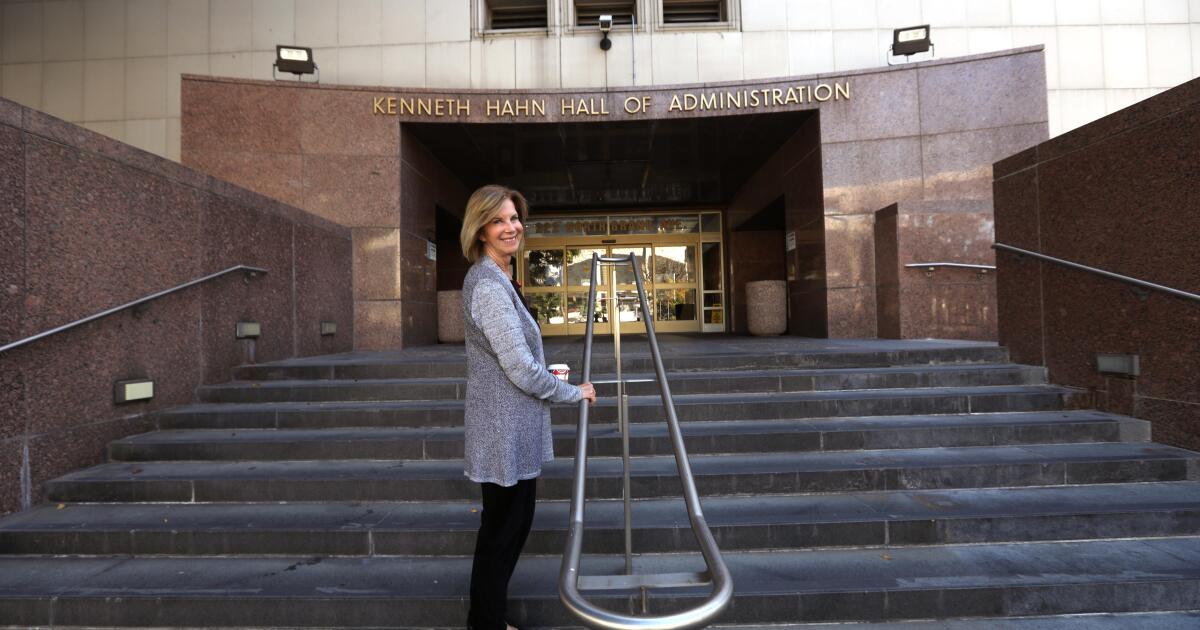Politics
Threats Reported in 2 States, but None Are Found Credible
Officials in Maine and Georgia said the discredited threats involved schools and polling stations. The F.B.I. also referred to bomb threats deemed not to be credible in several states, “many of which appear to originate from Russian email domains.”

Politics
Column: L.A. County's Hall of Administration should stand, Janice Hahn says. And not because of her dad

I drove around downtown Los Angeles on a recent Friday morning looking for one of the Civic Center’s ugly ducklings.
The Kenneth Hahn Hall of Administration … um, which building was it again?
It had been years since my only other visit, so unmemorable that I had forgotten how the ten-story structure looked. Google Maps gave me an address, but I was lost in a sea of architectural grandeur when I finally parked in a small lot near Temple and Grand. To my left was the majestic Cathedral of Our Lady of the Angels. Behind me were the Music Center’s elegant triplets of the arts: the Dorothy Chandler Pavilion, Mark Taper Forum and Ahmanson Theatre.
In front of me was a building with cream-colored tiles that connected to a taller building that looked the same, except with windows.
Oh, yeah. That’s the Hall of Administration.
Seat of the county of Los Angeles since it opened in 1960, it looks like a Lego block with slits. No wonder it’s never gotten as much love from Angelenos as its flashier neighbors, especially L.A. City Hall, which looms to the south like the haughty older civic cousin it is.
That’s why there hasn’t been any uproar since the county Board of Supervisors voted in November to buy the 52-story Gas Co. Tower for $200 million — a bargain worthy of the late, great 99 Cents Only chain, since its appraised value is $632 million — with plans to relocate county workers there, from the Hall of Administration and elsewhere, as early as this summer.
Nearly a third of the purchase price came from funds originally set aside to seismically retrofit the Hall of Administration and update its electrical system, effectively sentencing the place to the literal and historical scrap heap. The county’s preliminary plan calls for razing it, except for the portion where the supervisors hold their public meetings.
The sole “no” vote came from Janice Hahn, daughter of the Hall of Administration’s legendary namesake, the longest-serving supervisor in L.A. County history. She was waiting for me in the parking lot to give me a tour of the unloved building and argue for its virtue — and survival.
“This is Nate’s Lot,” she told me, explaining that it was named after a parking attendant who told her father he didn’t like working in the Hall of Administration’s underground garage. So the supervisor created the lot just for him.
“There’s history like that all around in a building like this,” said Hahn, Starbucks chai latte in hand, as we walked through the doors. Three staffers accompanied us, including Mark Baucum, who is both her son and her chief of staff.
“It has a warm feel, not like …” Her face scrunched as if she had stepped on a snail, and she waited a beat before referencing the county’s recent purchase. “That soulless skyscraper.”
Gloria Molina Grand Park is nestled alongside the Kenneth Hahn Hall of Administration, left, in Los Angeles. City Hall towers in the background.
(Genaro Molina / Los Angeles Times)
The halls gleamed with vintage charm. Marble walls and terrazzo floors. Frosted windows on doors with the old-school gold sans serif font long used by county departments. Phone booths that still work. Wood-paneled elevators that Janice and her brother, former L.A. mayor and current Superior Court Judge Jim Hahn, rode as kids like they were at an amusement park.
We walked through the spacious main lobby, where people waited in line to pay their property taxes, and out of the building toward Hill Street.
“That soulless skyscraper doesn’t have a lobby like this,” Hahn said. Across the street was the Hall of Records, built in 1962. To our left were the Stanley Mosk Courthouse, opened in 1959, and Gloria Molina Grand Park.
“They’re not on the chopping block,” she said, referring to the buildings. “People once thought City Hall was too expensive to retrofit. Were it not for civic-minded people, it would’ve been torn down. What a tragedy that would’ve been.”
As we rounded the Hall of Administration’s western side to look at large, gold-colored statues of Moses and Thomas Jefferson, the wear-and-tear of the 75-year-old building quickly became evident. Chunks missing from window ledges. Chipped granite base. Cracks on the walls here and there.
“Yes, it needs work,” Hahn acknowledged, as Baucum helped a woman who couldn’t tell the difference between the Hall of Administration and the Stanley Mosk Courthouse. “We had some of that money, but it was used to buy … that soulless skyscraper. And we have a budget of $50 billion. We can do this.”
Hahn estimated the cost to be $700 million. A spokesperson for L.A. County Chief Executive Officer Fesia Davenport said the seismic retrofit is expected to cost about $700 million, with renovations and other needed repairs bringing the estimated total to $1.8 billion.
But should it be done? I wondered as we went back inside the Hall of Administration. What possible role could an empty building play, when the other four supervisors want to get the hell out of there, and all of the money set aside to take care of it has already been spent?
One person I figured might have some pity for the Hall of Administration was Supervisor Kathryn Barger. She’s worked there since 1989 — first as an aide, then as chief of staff to then-Supervisor Mike Antonovich, and for the last eight years in her current role.
“From an aesthetic point of view, not much there,” said Barger, who voted to buy the Gas Co. Tower, in a phone interview. “You go to City Hall, you’re like, ‘Wow.’”
She gets Hahn’s point that it’s a historic structure, but Barger is more focused on the price tag for renovation, which she put at $1.2 billion. “I cannot discount Janice, but we have to do right by the taxpayers,” she said.
Barger mentioned that the supervisors are going to need much more office space after voters in November approved an eventual expansion of the board from five members to nine. She also brought up the late Gloria Molina, who served alongside Kenneth Hahn and whom Barger got to know well while working for Antonovich.
“Her vision and dream was to create more open space, and it was always shot down,” Barger said. She suggested that the Board of Supervisors could knock down the Hall of Administration, which spans the length of two city blocks, and expand Gloria Molina Grand Park.
“This issue is emotional for [Hahn],” Barger said, “but you have to separate the emotional from the reality.”

Supervisor Janice Hahn points out the word “beloved,” referring to her late father, on a plaque at the Kenneth Hahn Hall of Administration in Los Angeles.
(Genaro Molina / Los Angeles Times)
Hahn brought up that charge herself, then disputed it.
“Every story written implies it’s because of my father,” Hahn told me as we stood in front of a plaque near the lobby praising Kenneth Hahn’s “unsurpassed legacy of good works” in 40 years as a county supervisor. He died in 1997.
“It’s not,” she continued. “People have said, ‘We’ll put his name on the skyscraper.’ Oh, hell no. He would’ve questioned the rationale of using certain budget stats to prove” the necessity of leaving the Hall of Administration, she said. “He would find holes in their argument and find $700 million to save this hall.”
The tour went on for about an hour, with Hahn greeting every single person she passed. We visited the Board of Supervisors’ meeting room, which will remain standing (“That’ll make a disjointed county government”), and finally went up to her office. A painting hangs near the entrance, depicting her on a couch with a portrait of her dad hovering above.
“This is my life,” Hahn cracked. “My dad always looking over my shoulder.”
We briefly sat down, then went outside to a terrace ringing the length of the Hall of Administration. The floor was peeling, but the view before us of the Civic Center and downtown was stunning.
I understood, and even appreciated, Hahn’s argument that moving the county offices from here, where other parts of L.A. government reside, would create “a gaping hole in the idea of civic togetherness,” as her son put it. But the fiscal reasoning against it was strong, I said, before asking if her crusade stood any chance of succeeding.
“I think so,” she said. “I think we’ll get the momentum. And Dad always loved a good fight.”
Her son pointed out a sliver of a skyscraper poking out behind another skyscraper. That was the Gas Co. Tower.
“Ugh,” the supervisor said, shaking her head. “Soulless.”
After we said our goodbyes, I walked the four blocks to Hahn’s Moby Dick, which was built in 1991. She wasn’t wrong. The exterior is a bunch of charmless windows going up and up. The lobby, with its collection of elevators, scowling security guards and small glass turnstiles, is cold and anodyne. No amount of bureaucratic lipstick can pretty up this political pig.
Maybe Hahn was right, I thought as I headed back to Nate’s Lot. Then I ran into Miguel Santana, president of the California Community Foundation and a longtime Molina confidante.
I know few people who care about L.A. history and responsible leadership as much as he does. What does he think about the county abandoning the Hall of Administration?
“Great!” he said, barely breaking his stride. “I’m all for it. Gloria always wanted to knock it down and turn it into more park.”
Good luck with your fight, Supervisor Hahn: You’re going to need it.
Politics
What to know about race for speaker of the House

The House of Representatives will soon vote for a speaker of the House to lead the chamber for the next two years under the incoming Republican administration.
The previous race for the top House post was plagued by infighting among the GOP, who have been unable to easily find consensus on a speaker candidate in recent years. Former Rep. Kevin McCarthy, R-Calif., was ousted as speaker by his Republican colleagues in October 2023, and it took lawmakers several weeks to finally elect their next leader: Rep. Mike Johnson, R-La.
Johnson is running to retain his position in the next Congress but has not yet received support from all of his Republican colleagues. The 2025 vote carries particularly intense pressure as the House must agree on and elect a speaker in order to certify President-elect Donald Trump’s election victory just days later.
When will the House speaker vote take place?
The House is scheduled to vote on Friday, Jan. 3, 2025, at noon, as dictated by the Constitution.
THE HITCHHIKER’S GUIDE TO FAILING TO ELECT A HOUSE SPEAKER QUICKLY
House Speaker Mike Johnson is running for speaker of the 119th Congress. (Valerie Plesch)
A speaker must be elected before the 119th Congress can be sworn in.
Who is running?
Republicans have the majority in the House for the 119th Congress, so they are in charge of choosing a speaker.
Current House Speaker Mike Johnson is running again as head of the chamber. At this point, no other candidates have thrown their hat into the ring, but in past years, alternatives have been floated during the day of the vote.
How many votes does a candidate need to win?
Republicans currently hold a slim, four-seat majority in the chamber with 219 seats compared to the Democrats’ 215.

Speaker Kevin McCarthy swears in the officers of the House of Representatives at the U.S. Capitol on Jan. 7, 2023. (Kent Nishimura/Los Angeles Times)
The GOP majority is to dwindle even further when two of Trump’s Cabinet picks, Reps. Mike Waltz, R-Fla., and Elise Stefanik, R-N.Y., assume their roles pending Senate confirmation, which is expected to take place several weeks after the speaker vote.
A candidate for speaker must receive an outright majority to win. Given the number of seats held by the GOP, a Republican candidate would need 218 votes if all 434 members vote.
GOP LAWMAKER ‘FULLY SUPPORTS’ SPEAKER JOHNSON: ‘WE DON’T NEED A PROTRACTED SPEAKERS RACE’
Which Republicans have not committed to supporting Johnson?
Rep. Thomas Massie, R-Ky., recently told reporters he won’t vote for Johnson for speaker.
Another GOP member suggested that he has not yet committed to voting for Johnson: “Right now, I think that Mike has done an admirable job under tough conditions, but I’m going to keep my options open. I want to have a conversation with Mike,” Rep. Scott Perry, R-Pa., told Fox Business’ “Mornings with Maria.”

Rep. Thomas Massie, R-Ky., recently told reporters he won’t vote for Rep. Mike Johnson as House speaker. (Bill Clark/CQ-Roll Call/File)
House Minority Leader Rep. Hakeem Jeffries, D-N.Y., recently said Democrats won’t bail out Johnson if he does not receive enough GOP votes.
How could the recent government funding bill affect the vote?
Johnson introduced a government funding bill in early December, but the first proposal failed before it even reached the House floor after opposition from Republican lawmakers and outside Trump allies Elon Musk and Vivek Ramaswamy.
A second government funding bill was brought to the House floor, but bipartisan lawmakers voted against the legislation. Johnson introduced a third package, but many of his GOP colleagues didn’t support it. While 34 Republicans voted against Johnson’s bill, it passed in the House with unanimous Democrat support.
With more than two dozen Republicans breaking with Johnson on the government funding fight, he could face potential pushback against his speaker re-election efforts. Anywhere from four to 10 Republicans could oppose Johnson in the speaker’s race, Fox News’ Chad Pergram previously reported.
Could the House race affect the certification of the election?
The vote for speaker will take place on Friday, just three days before Congress is scheduled to certify the results of the Electoral College for Trump.

President-elect Donald Trump is endorsing Rep. Mike Johnson for speaker of the House. (Andrew Harnik)
The House cannot proceed with any official business, such as counting the presidential election votes for Trump, until a speaker is elected and the next Congress is sworn in. In January 2023, it took House Republicans four days and 15 ballots to elect a speaker.
Trump announced he would back Johnson for the position, a pivotal endorsement that could help determine the Louisiana Republican’s chances come Friday’s vote.
“The American people need IMMEDIATE relief from all of the destructive policies of the last Administration. Speaker Mike Johnson is a good, hard working, religious man. He will do the right thing, and we will continue to WIN. Mike has my Complete & Total Endorsement. MAGA!!!” Trump wrote in a Truth Social post on Monday.
Fox News’ Chad Pergram contributed to this report.
Politics
Opinion: Jimmy Carter had a second term. It just wasn't in the White House

At a campaign event in Winston-Salem on the eve of the 1976 North Carolina Democratic primary, a voter asked then-candidate Jimmy Carter whether he was a “born again” Christian. Carter, a Southern Baptist Sunday-school teacher, replied that, yes, he was “born again,” thereby sending a legion of journalists from outside the Bible belt to their Rolodexes to figure out what in the world he was talking about.
Carter sought throughout his life to act on the principles of his faith, which was defined in part by the extraordinary activism of 19th century evangelical Christians who worked assiduously on behalf of those Jesus called “the least of these.” They were involved in peace crusades and helped to organize public schools so that the children of those less affluent could become upwardly mobile. Northern evangelicals worked for the abolition of slavery. They supported prison reform and women’s suffrage.
Carter’s progressive evangelicalism was very much in that tradition. He was sensitive to racial inequalities from a young age and tried to address them — as school board member, as governor and as president. He supported women’s equality, including the proposed Equal Rights Amendment.
As president, Carter tried to nudge American foreign policy away from its reflexive Cold War dualism toward an emphasis on human rights. He recognized that if the United States were to have any meaningful relationship with Latin America, we needed to attenuate our colonialism, so he pushed through the ratification of the Panama Canal treaties. He advanced peace in the Middle East farther than any of his predecessors (or successors), and he appointed more women and people of color to federal office than any previous president. Many environmentalists consider him the best president ever for their cause.
Carter’s failure to win reelection in 1980 devastated him. He departed Washington for Plains, Ga., at 56, the youngest president to leave office since William Howard Taft.
Rosalynn was especially embittered by the election loss. In one of our interviews decades after the 1980 election, Carter told me that in the course of his frequent reassurances to his wife that they still had productive years ahead of them, he began to believe his own rhetoric. He also conceded that if he had been president for four more years, that second term would not have been nearly so fruitful as the alternative turned out to be.
Carter’s post-presidency began with a middle-of-the-night idea. In addition to a presidential library, Jimmy told Rosalynn, “We can start an adjacent institution, something like Camp David, where people can come who are involved in a war. I can offer to serve as a mediator, in Atlanta or perhaps in their countries. We might also teach how to resolve or prevent conflict.”
This would be an entirely new model for out-of-office presidents — a privately funded nonprofit center to advance his goals and allow him to address issues he would have pursued if he’d stayed in the White House.
In a list of basic principles for the center, Carter stipulated that it would be nonpartisan and that it would not duplicate the programs of other institutions, such as the United Nations. Most important, Carter wanted an “action agency,” an institution devoted to change rather than simply “theoretical or academic analysis.”
The Jimmy Carter Presidential Library and Museum, along with the Carter Center, was dedicated in Atlanta on Oct. 1, 1986, Carter’s 62nd birthday. His faith undeniably informed every effort at the center. Carter told an interviewer in 1988 that the life of Jesus had always been his guide. “I don’t see any disharmony in this life between evangelistic effort on the one hand and benevolent care of people who suffer or who are in need on the other,” he said. “I think they are intimately tied together.”
Carter understood problems afflicting the world as spiritual challenges in part, noting that industrialized Western society had failed to adopt Christian principles of concern and caring. He believed that people of privilege, and especially people of faith, bore a special responsibility for those less fortunate, for those who suffer and are deprived. “That’s where Jesus spent all his ministry,” Carter said. Piety alone wasn’t sufficient; followers of Jesus must live out their convictions with acts of charity.
Early on, Carter identified access to healthcare, including mental healthcare (one of Rosalynn’s concerns), as a fundamental human right, noting at one point that 40,000 children die every day from preventable diseases. Using education and simple, low-cost methods, the Carter Center’s health initiatives addressed “neglected tropical diseases”: lymphatic filariasis, trachoma, schistosomiasis and malaria. Other programs targeted guinea worm and river blindness (onchocerciasis), extraordinary initiatives that have achieved near eradication of those diseases in regions where the Carter Center has been active.
Peace and conflict resolution, the second focus of the Carter Center, built on Carter’s success in negotiating the Camp David accords. “We need to deal with other people with mutual respect,” Carter told an audience at Messiah College in 1988, “and through that kind of approach there can be peaceful resolution of differences through the use of diplomacy and negotiation, not through the use of military power.”
The center conducted programs on democracy and human rights and monitored elections in dozens of countries. Carter leveraged his relationships with world leaders to mediate various disputes, including those in Guyana, Ethiopia and Serbia. In 1994, Carter convinced Kim Il Sung to open North Korea’s nuclear reactors to inspectors. In Haiti the following year, U.S. military planes were headed toward the island when Carter, together with Colin Powell and Georgia Sen. Sam Nunn, persuaded the military junta to abandon power.
Carter’s persistent efforts at conflict resolution, dating back to the Camp David accords of 1978, were recognized with the Nobel Peace Prize in 2002.
Jimmy and Rosalynn, who died in November 2023, extended their public service beyond the Carter Center, too — most notably with Habitat for Humanity, which Carter once described as “the most practical, tangible way I’ve ever seen to put Christian principles into action.” During one of our conversations, Carter choked up when he told of completing a house for a woman and her family who had been living in an abandoned septic tank.
Carter’s alternative “second term” lasted for more than four decades. Out of the ashes of political annihilation, he became not just an elder statesman and world-renowned humanitarian but arguably the most consequential of modern former presidents.
James Laney, former president of Emory University, partner of the Carter Center, offered the best and most succinct characterization of the man from Plains. Carter, Laney remarked, was “the first president to use the White House as a stepping stone.”
Randall Balmer, the John Phillips Professor in Religion at Dartmouth College, is the author of “Redeemer: The Life of Jimmy Carter.”
-
/cdn.vox-cdn.com/uploads/chorus_asset/file/25672934/Metaphor_Key_Art_Horizontal.png)
/cdn.vox-cdn.com/uploads/chorus_asset/file/25672934/Metaphor_Key_Art_Horizontal.png) Technology1 week ago
Technology1 week agoThere’s a reason Metaphor: ReFantanzio’s battle music sounds as cool as it does
-

 News1 week ago
News1 week agoFrance’s new premier selects Eric Lombard as finance minister
-

 Business1 week ago
Business1 week agoOn a quest for global domination, Chinese EV makers are upending Thailand's auto industry
-

 Health5 days ago
Health5 days agoNew Year life lessons from country star: 'Never forget where you came from'
-
/cdn.vox-cdn.com/uploads/chorus_asset/file/24982514/Quest_3_dock.jpg)
/cdn.vox-cdn.com/uploads/chorus_asset/file/24982514/Quest_3_dock.jpg) Technology5 days ago
Technology5 days agoMeta’s ‘software update issue’ has been breaking Quest headsets for weeks
-

 World1 week ago
World1 week agoPassenger plane crashes in Kazakhstan: Emergencies ministry
-

 Politics1 week ago
Politics1 week agoIt's official: Biden signs new law, designates bald eagle as 'national bird'
-

 Politics7 days ago
Politics7 days ago'Politics is bad for business.' Why Disney's Bob Iger is trying to avoid hot buttons












